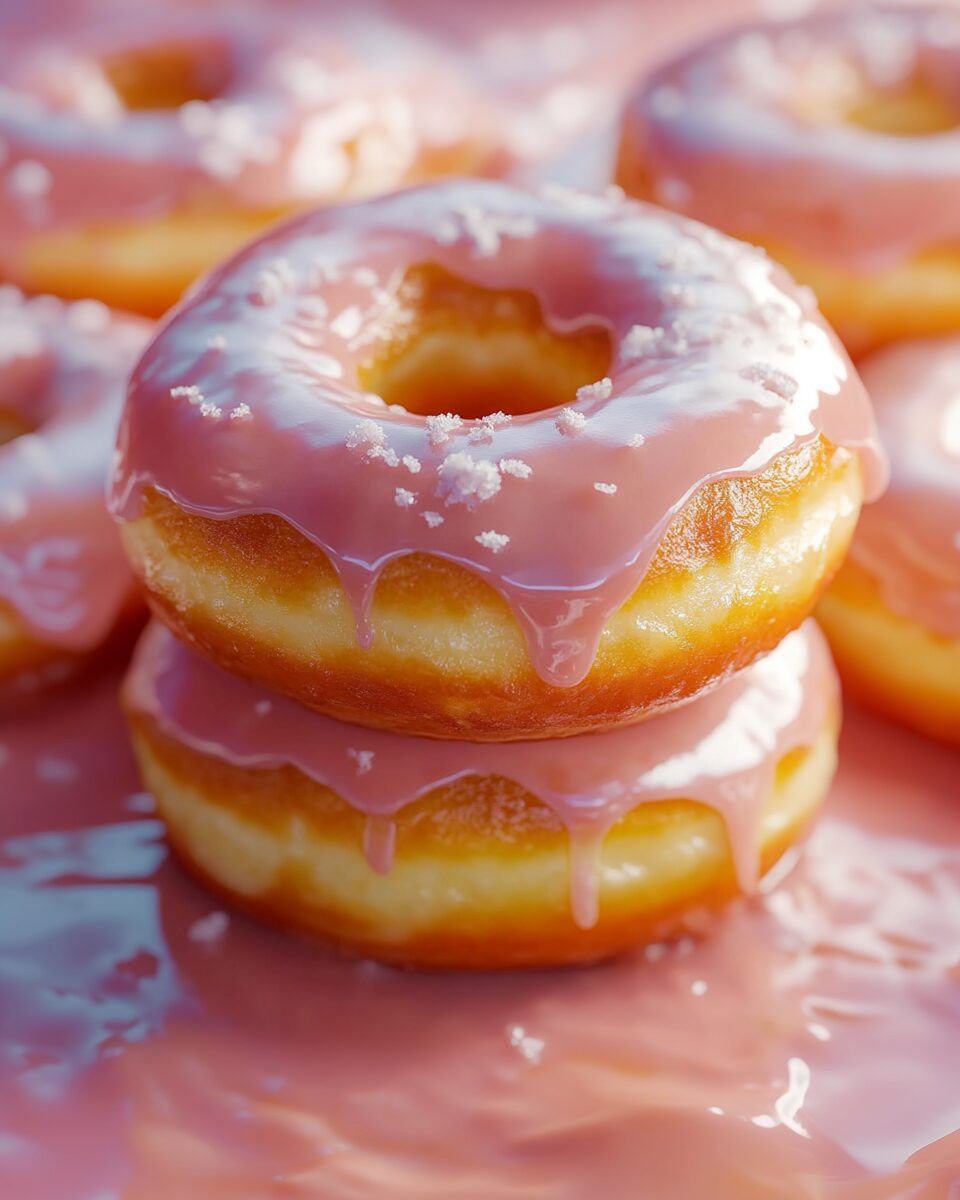There’s something truly magical about a fresh, warm glazed donut straight out of the fryer. These homemade glazed donuts are soft, fluffy, and incredibly satisfying—comparable to those from your favorite donut shop, if not better. With a pillowy texture inside and a shiny, sweet glaze outside, they strike the perfect balance of decadence and comfort. Making donuts at home may seem intimidating at first, but this recipe breaks it down into easy-to-follow steps that result in consistent, bakery-style perfection. Whether you’re preparing them for a special brunch, dessert, or a weekend treat, these donuts will win over everyone with their melt-in-your-mouth texture and classic vanilla glaze.
Full Recipe:
Ingredients
For the Donut Dough:
-
2 1/2 cups all-purpose flour, divided, plus more for dusting
-
1/4 cup granulated sugar
-
1/4 teaspoon salt
-
1 packet instant yeast (about 2 1/4 teaspoons)
-
2/3 cup milk, scalded and cooled to 115˚F
-
1/4 cup light olive oil (or vegetable/canola oil)
-
2 egg yolks, room temperature
-
1/2 teaspoon vanilla extract
For the Glaze:
-
1 pound (about 4 cups) powdered sugar
-
5 to 6 tablespoons water
-
1 tablespoon vanilla extract
For Frying:
-
High-heat oil for frying (peanut, vegetable, or canola)
Directions
1. Scald and Cool the Milk
Begin by heating the milk in a small saucepan over medium-low heat. Stir continuously to prevent the formation of a skin or film. Once the milk reaches 180˚F or starts to steam, remove it from the heat and pour it into a measuring cup. Let it cool down to 115˚F. This step is important for activating the yeast properly.
2. Mix the Dough Base
In a large bowl, combine 1 cup of the flour, sugar, salt, and yeast. Add the warm (not hot) milk, oil, egg yolks, and vanilla extract. Whisk the ingredients together until smooth. The mixture should be a bit thick and bubbly after a few minutes.
3. Let the Yeast Activate
Cover the bowl with plastic wrap and let the mixture sit for 10 to 15 minutes at room temperature. You should see bubbles forming on the surface—this means the yeast is alive and ready.
4. Knead the Dough
Add the remaining 1 1/2 cups of flour to the bowl, stirring until a dough forms. It should pull away from the sides of the bowl but still feel slightly sticky. Knead it by hand directly in the bowl for about 5 minutes. If the dough sticks excessively, dust with a bit more flour.
5. First Rise
Cover the bowl again with plastic wrap and allow the dough to rise. For a quick rise, place it in a warm area (around 100˚F) for about 45 minutes, or at room temperature for 1.5 to 2 hours. The dough should double in size.
6. Roll and Cut the Donuts
Once risen, transfer the dough onto a floured surface. Roll it out to a thickness between 1/4 and 1/3 inch. Use a donut cutter (or two round cutters of different sizes) to cut out donut rings. You should get 11 to 12 donuts and the same number of holes. You can gently knead and re-roll any scraps.
7. Second Rise
Place the cut donuts and holes onto a parchment-lined baking sheet. Make sure they have enough room to puff up without touching. Cover loosely with a clean kitchen towel and let them rise for another 20 minutes in a warm spot or 45 minutes at room temperature.
8. Prepare the Glaze
While the donuts rise, make the glaze. In a large bowl, whisk together the powdered sugar, water, and vanilla extract until smooth and runny. You want the glaze to coat the donuts lightly while still setting into that beautiful transparent sheen.
9. Fry the Donuts
Heat oil in a Dutch oven or deep fryer to 375˚F. Carefully drop in 2 to 3 donuts at a time, frying each side for about 60 seconds or until golden brown. Flip carefully using chopsticks or a slotted spoon. Transfer to a wire rack to drain excess oil.
10. Glaze the Donuts
While still warm, dip each donut into the prepared glaze, turning to coat both sides. Allow the excess glaze to drip off, then return to the rack. The glaze will harden slightly as it sets, giving the donuts their signature shine.
11. Finish and Serve
Repeat the frying and glazing process for the remaining donuts and donut holes. Serve fresh, ideally while still warm for the best texture and flavor. Leftovers can be stored in an airtight container, but they’re best enjoyed the same day.
Nutrients
Here is an approximate nutritional breakdown per glazed donut:
-
Calories: 229 kcal
-
Total Fat: 6 g
-
Saturated Fat: 1 g
-
Cholesterol: 33 mg
-
Sodium: 57 mg
-
Carbohydrates: 40 g
-
Sugar: 20 g
-
Fiber: 1 g
-
Protein: 4 g
-
Calcium: 25 mg
-
Iron: 1 mg
-
Vitamin A: 69 IU
-
Potassium: 54 mg
A Brief History of the Donut
The origins of the donut date back thousands of years. Ancient civilizations, including the Greeks and Romans, had their own versions of fried dough, often sweetened with honey. These early iterations were simple, but the method of frying dough became widespread due to its delicious results and ease of preparation.
The modern donut, particularly the variety with a hole in the center, is believed to have been influenced by Dutch settlers in early America. They brought with them “olykoeks,” or “oil cakes,” which were balls of sweet dough fried in fat. These sometimes had uncooked centers, leading to the innovation of adding fillings like nuts or fruits.
The famous donut hole is commonly attributed to Captain Hanson Gregory, an American sailor, who reportedly punched out the middle of the dough to ensure even cooking. This small change revolutionized the donut’s structure and became the standard we know today.
The Rise of the Glazed Donut
As donuts became popular in the U.S., variations naturally emerged. The glazed donut—dipped in a simple sugar-based icing—rose to prominence due to its visual appeal and enhanced sweetness. Unlike powdered or filled donuts, the glaze provides a shiny, delicate shell that melts in your mouth, complementing the fluffy interior without overwhelming it.
Cultural Impact and Popularity
Glazed donuts are more than just a treat—they’re a part of social rituals, work culture, and family traditions. The “donut run” has become a morning staple in offices. Kids love them as after-school snacks. They appear at brunches, birthdays, and even weddings.
Artisanal vs. Classic
The glazed donut has evolved in two main directions: the mass-produced, traditional kind and the artisanal, gourmet version. While the traditional glazed donut is celebrated for its simplicity and nostalgia, modern bakeries and chefs have elevated the basic formula with premium ingredients, unique glazes, and elaborate toppings.
Artisanal donuts might include bourbon-maple glazes, citrus-infused icing, or even edible gold leaf. These are often larger, more visually striking, and made in small batches to emphasize quality. While some purists prefer the no-frills original, others enjoy exploring the creativity of the donut as a canvas for flavor experimentation.
Texture and Taste: The Sensory Appeal
One of the most important aspects of a glazed donut is its texture. A perfect glazed donut is light and airy, with a slight chew from the well-developed dough. The exterior should be golden and crisp, while the interior remains tender. The glaze adds a smooth, sticky sweetness that complements but doesn’t overpower the dough.
Homemade vs. Store-Bought
There’s an undeniable charm to making glazed donuts at home. While it requires time, especially for yeast-based recipes, the results are often more flavorful and fresher than store-bought varieties. Home cooks can control the quality of ingredients, experiment with flavors, and enjoy the unbeatable experience of a warm donut straight from the fryer.
Store-bought glazed donuts, especially from popular chains, offer consistency and convenience. They’re great for quick treats and events. However, they often include preservatives and stabilizers to extend shelf life, which can affect texture and taste.
Ultimately, both versions have their place, and personal preference plays a big role. Some prefer the nostalgic taste of a boxed donut, while others relish the rewarding process of homemade baking.
Glazed Donuts Around the World
Though the classic American glazed donut is iconic, many cultures have similar fried-dough treats. In Poland, there’s the pączki—typically filled and sugar-dusted but sometimes glazed. In Italy, bomboloni offer a custard-filled twist. In India, gulab jamun is a syrup-soaked dough ball, rich and sweet, often likened to a dessert donut.
Modern Trends and Innovations
The donut industry has embraced trends such as vegan, gluten-free, and keto baking. Glazed donuts are no exception. Bakers now use alternative flours, dairy-free milks, and natural sweeteners to craft health-conscious versions of this classic dessert.
Why We Love Them
The appeal of glazed donuts is both emotional and sensory. They are tied to childhood memories, family traditions, and everyday rituals. They offer a moment of escape—a small indulgence in an otherwise routine day.
From a flavor perspective, the balance of sweetness, warmth, and texture is hard to beat. Unlike heavily frosted or filled desserts, glazed donuts are simple yet satisfying. They offer that first-bite joy without overwhelming the senses.
Conclusion
The glazed donut is more than a pastry—it’s a cultural symbol, a nostalgic comfort, and a sweet reward. Its journey from ancient fried dough to modern-day dessert icon reflects how food evolves while staying rooted in tradition. Whether classic or artisanal, store-bought or homemade, the glazed donut remains a timeless treat that continues to delight across generations.






